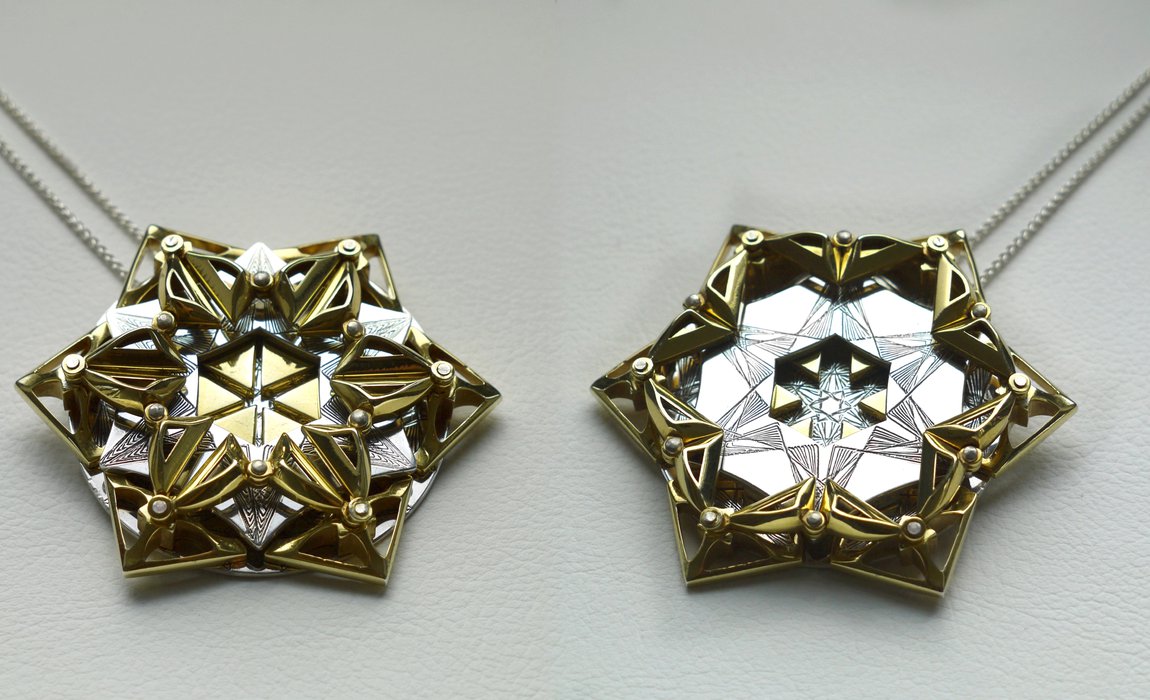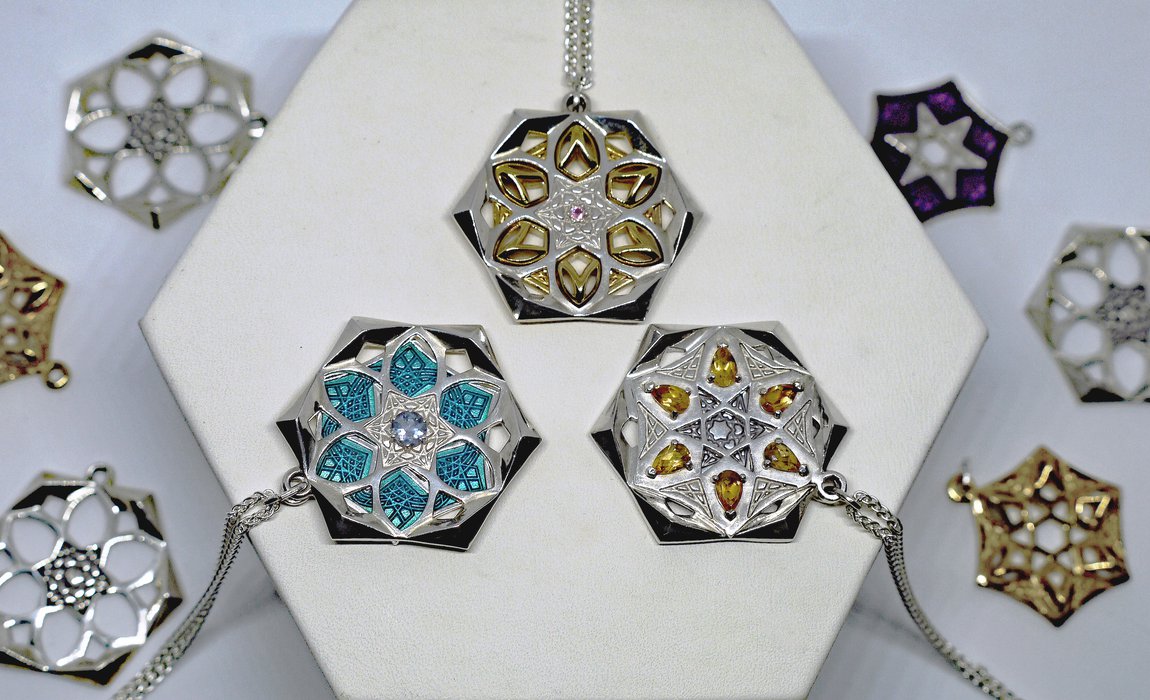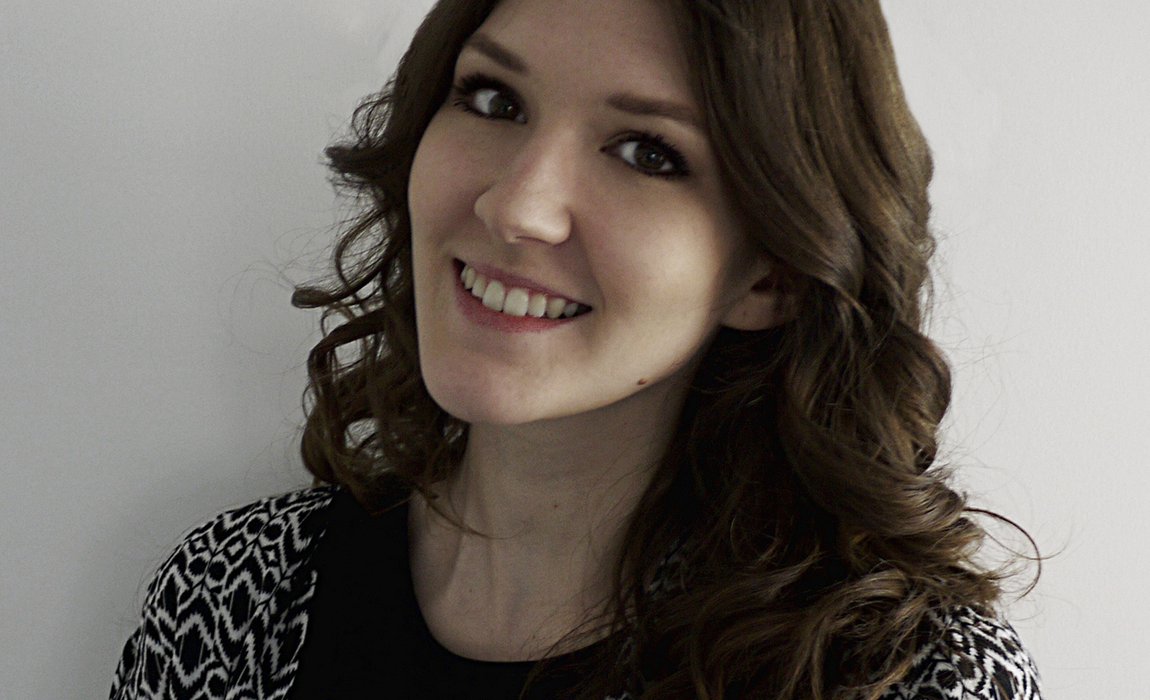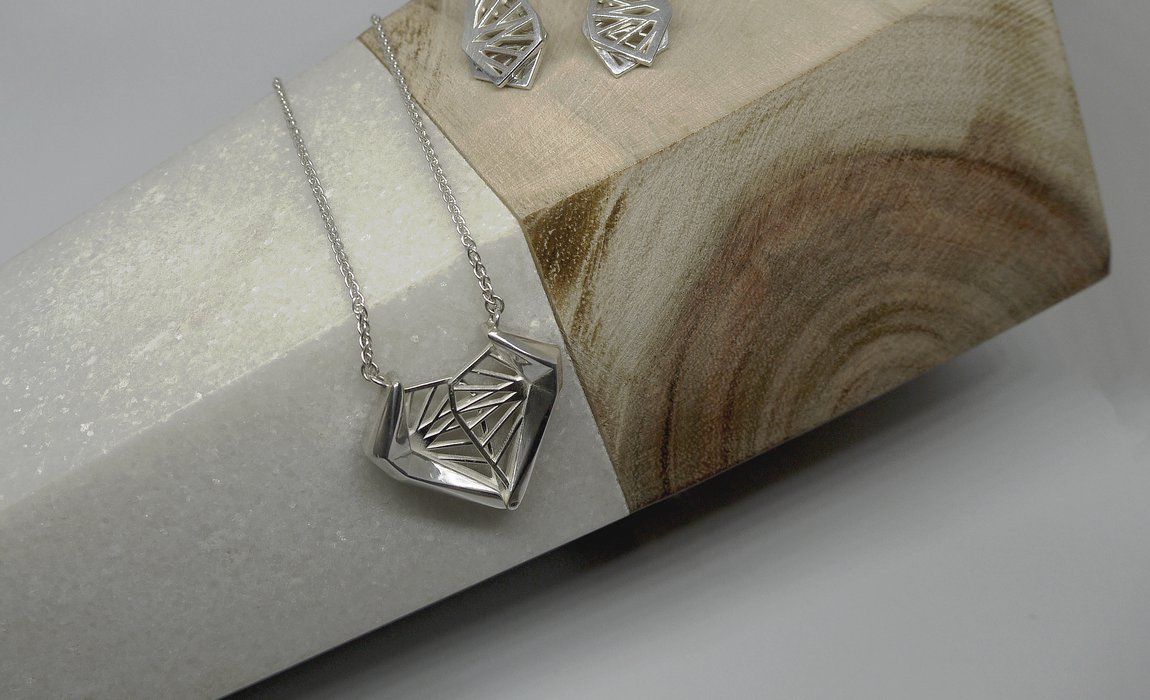Shine 2017: Jeweller Steff Wills
Jeweller Steff Wills will be exhibiting in our annual selling showcase Shine 2017 at the Goldsmiths’ Centre. In this interview, Steff shares how her interest in Architecture and Kaleidoscopes fed into the design of her kinetic jewellery pieces.

Hi Steff, thank you for joining me today. Could you tell me a little bit about yourself?
Well I currently work full-time as a bespoke CAD designer at Weston Beamor. But in my spare time, I focus on creating my own jewellery because I am always thinking of innovative ideas. I also work in CAD to create a lot of my pieces as they are quite technically intricate and require a lot of precision. I have a fascination with different shapes and forms, which is where my ideas come from and I then create transforming jewellery to pass on this playful exploration to the wearer.
How did you decide on a career in jewellery?
When I left school, I went to Loughborough University to study 3D design. The course was craft based and we learnt lots of disciplines, one of my specialisms being jewellery and textiles.
I really liked fashion and product design at school and I felt that jewellery was a combination of the two; small scale products and fashion inspired jewellery pieces. After I graduated from Loughborough in 2014, I had a few different jobs and did a couple of internships, specialising in the craft and design industry. I worked at a jewellery retailer for a little while and decided I wanted to learn more about the jewellery industry. I was really interested in CAD design, the uses of 3D printing and modern manufacturing technologies that were being used in the industry, so I went back to University and studied a BA at Birmingham City University’s School of Jewellery in Design for Industry, which is where I learnt a great deal of my design skills.
From there, I developed a larger collection that I took to International Jewellery London in 2016 where I was awarded Bright Young Gem. My collections have developed from there really, I try to keep creating and making new things all the time.

Your work, including your Concealed Series, evokes playful interaction. In what ways do you want the wearer to engage with your work? And where does your inspiration stem from?
I am inspired by geometric forms, pattern and repetition. I find Architecture really fascinating because of the repeating and symmetrical shapes often found in different buildings. When sketching new designs, I take different shapes and elements from forms that I like, to create patterns and work from there. I’m also inspired by patterning from Spirographs and Kaleidoscopes which greatly influenced my current collection. I started out by sketching patterns and picked out elements that I liked, I then slotted these elements together and drew new patterns. I’ve developed a couple of shapes and patterns that I like which you can see bits of throughout my collections.
I always try to evolve my designs by taking elements from one piece and bring it into the next, changing it ever so slightly to get a new shape. The smaller scale pieces like the reversible medallions and the lattice pendant take elements of my larger pieces but are much more wearable. The reversible medallion has two sections that slot together so you can see a glimpse of the enamel sections through the cut-out section in the front, or you can reverse these and you can see the whole enamel section with just the edges of the front peeking through.
I try to keep it simplistic to allow the wearer to discover different patterns, for example in the Kaleidoscope spinning ring, the two halves have quite simple lines, but once they’re together they make different shapes. Similarly, the Concealed Ring in my collection has a stone hidden underneath the moving layers, so the wearer can see one pattern when its closed, then as they look deeper and start to play with the ring a bit more, they can find the hidden elements. The pendant also has hidden engraved patterning, and as you move the different sections of the pendant it reveals more of the second pattern. I want people to explore the design of it and find out more about the piece for themselves.

How do you go about making your intricate kinetic pieces shown at Shine 2017?
The majority of my work is designed on the computer, so I rely on my CAD skills, especially when working out the mechanisms. I do a lot of testing as well, I 3D print the different elements to check if they fit together, and play around with the mechanisms. When I’m happy with the fit I then 3D print all the intricate components and cast them. Most of the work is then in the assembly of the components to ensure fluid movement to create a kinetic final piece.
The most complex design is the Concealed Pendant which is comprised of about 20 pieces. Once they’re all cast, I’ll clean them up at the bench and assemble them by hand, so all the mechanisms interlock and fit together. I eventually hinge, and laser weld the moving elements to bring together the finished piece.
What piece of jewellery do you think everyone should have in their personal collection?
I really love rings and pendants. As you can probably tell, I fiddle with my jewellery which I guess is why I’ve made kinetic jewellery. I like pendants because I think that they can complete an outfit. You can make an outfit with just a plain t-shirt and either a stunning big necklace, or a delicate little pendant, I think that either create the focal point of an ensemble. I always wear necklaces and rings, especially rings because I like to stack them. I have one stacking ring in my collection, two rings that you can wear on their own or they slot together. One then spins on top of the other, so kind of like a Kaleidoscope, you can see the patterns moving and again you can play around with the patterns with that while it’s on your finger which I really love.

How would you like your jewellery to be worn and by whom?
My jewellery is quite decorative and unique. I would like someone to be wearing it because they find it fascinating and want it to be a centrepiece of their outfit. The larger pieces are quite eye-catching and as for the smaller pieces, I think it would be someone who wants something a bit more versatile. My pieces can be worn one way to work and then a different way in the evening. They can flip them or they can open them out and will look quite different.

Last year, you won many awards, such as HSBC Worldwide Banking Cooperation: Winner of Design competition for Commemorative Medal and Guild of Jewellery Designers: New Designer Award. What are you planning to do next?
Last year was an amazing year for me. Now, I’ve got lots of innovative ideas and I’m working on new large-scale pieces which I’d really like to develop for the new year. I want to push the development of the mechanisms from my Concealed Series, and make some more large statement rings. I hope to develop those large pieces and then begin to expand my small-scale collection around them. I am also taking part in Getting Started at the Goldsmiths Centre in January which I am really excited to learn more in depth about my business development.
Doing more exhibitions would be high on my list for next year. I think they are great because you get to meet so many new people, and especially for myself being quite a young brand, it’s a brilliant way to get feedback and meet other people in the industry.
For more information on the Shine 2017 exhibitors and to start commissioning your pieces, visit www.goldsmiths-centre.org/whats-on/exhibitions/shine-2017